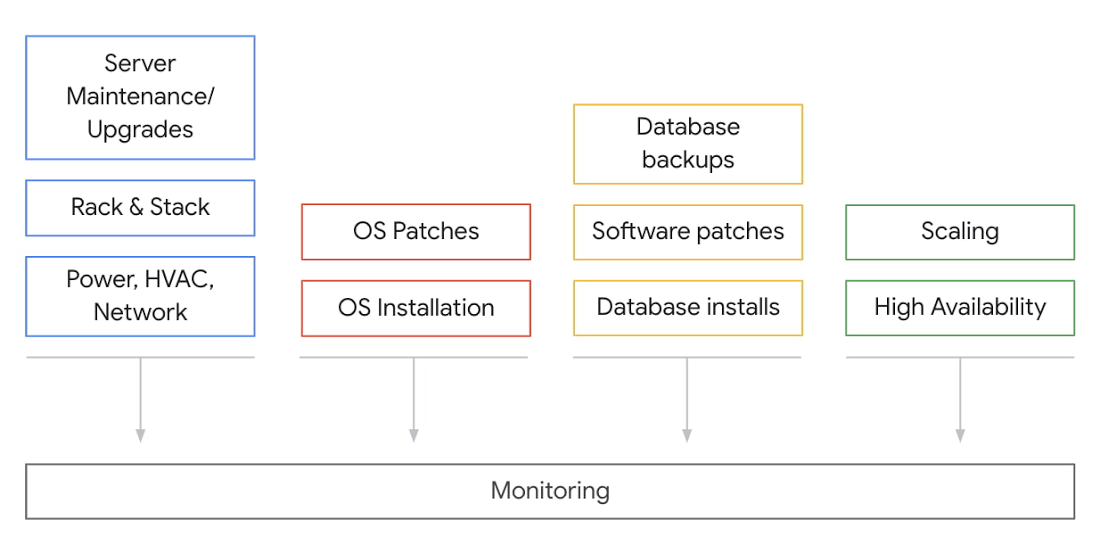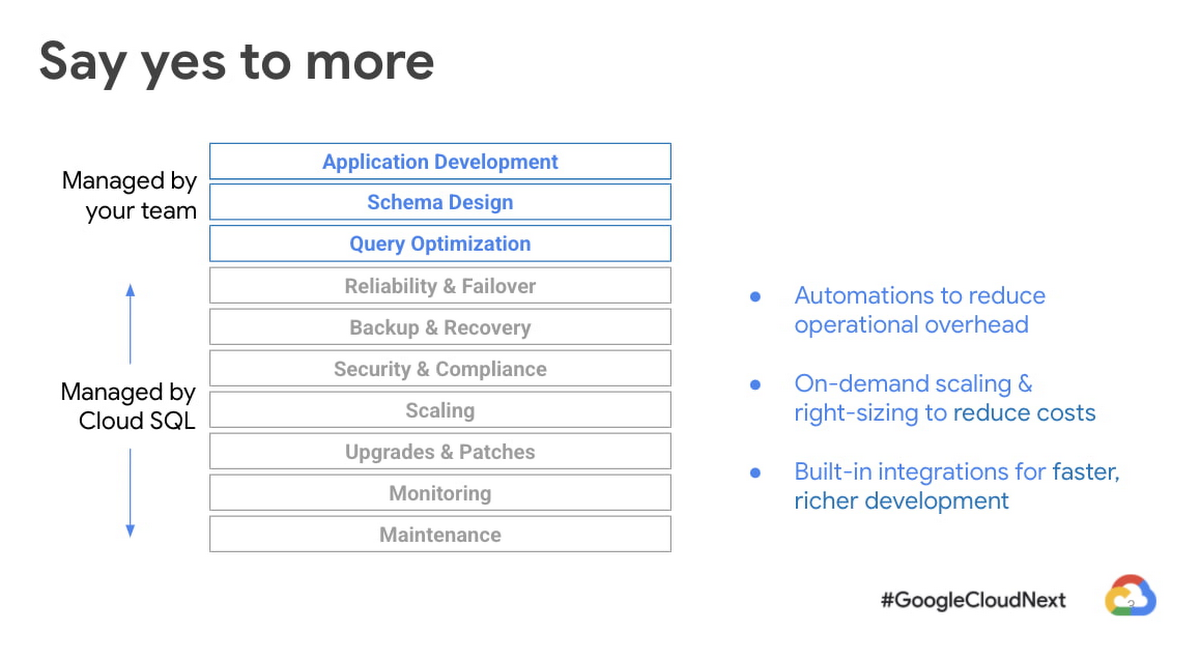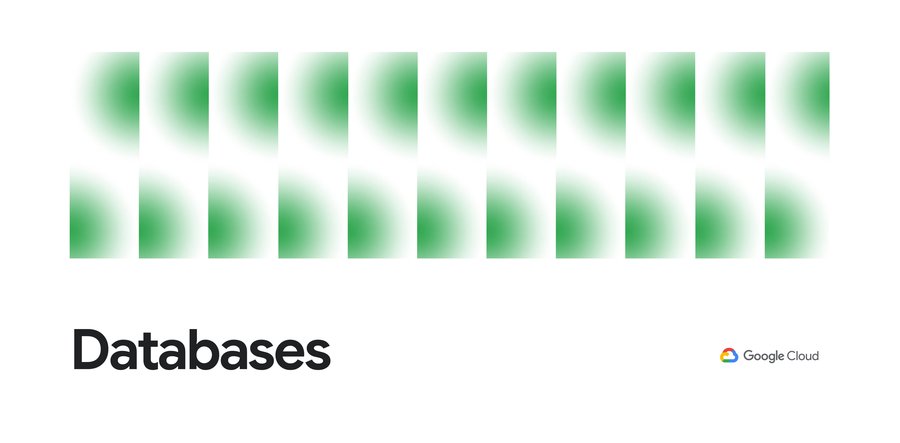Understanding the value of managed database services
Kelly Stirman
Product Manager, Google Cloud
Organizations are increasingly short on time, talent, and resources to manage and tune databases to suit their needs. For this reason, many businesses are turning to fully managed database services to help them build and scale their infrastructure to keep up with the data-driven demands of today’s always-on world.
Cloud SQL offers industry-standard relational databases and manages common database administration tasks for MySQL, PostgreSQL, and SQL Server. Using Cloud SQL enables businesses to spend less time managing their database infrastructure, and more time focusing on their applications.
Thousands of customers, large and small, trust Cloud SQL with their databases—and they have made it one of the fastest-growing services in Google Cloud. We often hear from customers that Cloud SQL helps free up time previously spent on database administration. Cloud SQL is one of our fully managed cloud services. Managed services can generally free up time and resources for your organization.
What is a managed database?
A managed database is an on-demand cloud computing service, which includes everything you need to run your databases. Below is a diagram of the typical technology stack needed to run a database deployment:


With a managed database service, none of this is your responsibility. Instead, the cloud provider is responsible for looking after and maintaining infrastructure, patches, and other maintenance tasks that would normally consume a significant amount of your time and resources.
Benefits of a managed database like Cloud SQL
Why are managed databases so popular? Here are just a few reasons:
Self-service improves developer velocity
Manual database provisioning is a slow process, making it difficult to scale resources on the fly. With Cloud SQL, developers can easily automate the process to create, modify, clone, and replicate database servers. Powerful and intuitive interfaces make these tasks simple to use and automate.
Google SRE teams have your back 24 x 365
Google wrote the book (or should we say books) on Site Reliability Engineering, and Cloud SQL delivers round-the-clock SRE support and multiple layers of protection to ensure a reliable and secure service.
Automated tasks save time while keeping data secure
Maintenance to deliver new feature updates and security is a part of everyday database management—but it’s also time-consuming. Cloud SQL automates tasks for HA, backup, disaster recovery, security patching and upgrades. Your deployments can run smoothly and securely.
Organization policies provide safety guardrails
Development always wants to run faster, but security and compliance teams can struggle to keep up. Cloud SQL organization policies provide centralized, programmatic control over your organization’s cloud resources without slowing innovation.
More “yes,” less “no”
With more scale, more user demands, and changing business needs, there’s always pressure to deliver more, faster. By moving to Google’s managed Cloud SQL services, teams can say yes to more, without increasing headcount.
Flexible pay-as-you-go options
Provision your databases based on your current usage patterns, with the ability to increase or decrease your footprint and costs on-demand.
Advanced security and reliability
The hardware is controlled, built, and hardened by Google. There are no trust assumptions between services. All identities, users, and services are strongly authenticated. Data stored on our infrastructure is automatically encrypted at rest. Communications over the Internet to our cloud services are encrypted. The scale of Google’s infrastructure allows it to absorb many Denial of Service attacks, and Google Cloud’s SRE teams are on-call 24 x 365, helping detect threats and respond to incidents.
A super fast, high-performing global network
Google’s network uniquely provides global connectivity with its system of high-capacity fiber optic cables that encircle the globe. This enables simple and robust cross-regional operations and redundancy, without the need to set up dedicated connections between Google Cloud regions. With this network, our database services can create resources in different regions, simplifying how applications provide great experiences to customers, no matter where they are on the globe.
Optimal integrations with popular tools and Google Cloud services
Databases need ecosystems. Google provides extensive support for dozens of Google Cloud services, the most popular ORMs, tools, libraries, and frameworks. This includes robust integrations with Google Kubernetes Engine (GKE), direct queries from BigQuery, and multiple data integration services, such as Cloud Dataflow, Data Fusion, Pub/Sub, and more.
Economic advantages of managed databases
According to Research Vice President Carl Olofson, IDC has conducted a number of business value studies focused on the experience of enterprises moving databases from an environment they have configured and managed themselves to managed database cloud services. In these, we compared total hardware, software, and staff time costs for the self-managed database versus the total staff time and subscription cost of the managed cloud database service over five years. We have certain outcomes that are consistent, regardless of the database brand or cloud service provider:
enterprises generally experience a ROI in excess of 400% over five years,
the payback period is less than a year,
users experienced better and more consistent database performance,
unplanned downtime was drastically reduced, resulting in significant avoidance of costs due to data unavailability, and
the greater security afforded by the cloud environment and the regular application of security patches to DBMS code resulted in substantial peace of mind, the benefit of which cannot be quantified.
How does Cloud SQL work?
With Cloud SQL, you can create an instance and configure it with the right combination of vCPU cores and RAM for your workload—and the rest is automated. Cloud SQL automatically ensures your databases are reliable, secure, and scalable so that your business continues to run without disruption. Flexible instance shapes allow you to optimize the balance of compute, storage, and memory for each deployment. The underlying Google Cloud infrastructure is highly optimized for predictable, high performance operations with edition-agnostic capabilities such as storage-based HA—and run according to our SRE principles.
First, Cloud SQL manages installation and ensures the database is kept up-to-date with automated upgrades and patching. We also protect your data with automatic, regularly scheduled backups that are retained for up to a year.
From there, we offer options, such as high availability (HA), including health checks and automatic failover, using synchronous replication for cross-region replication for disaster recovery.
Cloud SQL wraps this technology stack in powerful and intuitive interfaces that make sense for developers and operations teams: API, CLI, and UI. Your teams can easily provision databases in minutes. The entire stack is also monitored so you can quickly find the root cause when a problem occurs.
Managed databases can open up new possibilities for teams within an organization.


Migrating to a managed database
Making the decision to migrate from on-premises to a managed database solution can be risky. While managed services can reduce the stress of deploying and maintaining a database, you also need to trust that your applications will continue to run and that you can continue to use the same tools and skill sets.
Cloud SQL removes that risk, allowing you to get started fast with minimal-downtime migrations using our Database Migration Service.
Here’s why:
Keep running as usual. You get the familiar MySQL, PostgreSQL, and SQL Server engines you’re used to with no additional modifications and automatic access to the latest enhancements.
Seamlessly integrate with your preferred tools. Connect to your Cloud SQL instances with common database administration and reporting tools, such as MySQL Workbench, Toad SQL, and SQuirrel SQL, and pgAdmin.
No disruption or surprises. Easily migrate your databases and get started with a few clicks using the native Database Migration Service for zero-downtime migrations.
If you’re interested in learning more about Cloud SQL (and the rest of our data storage, management, and analytics platform), join the upcoming Data Cloud Summit.




